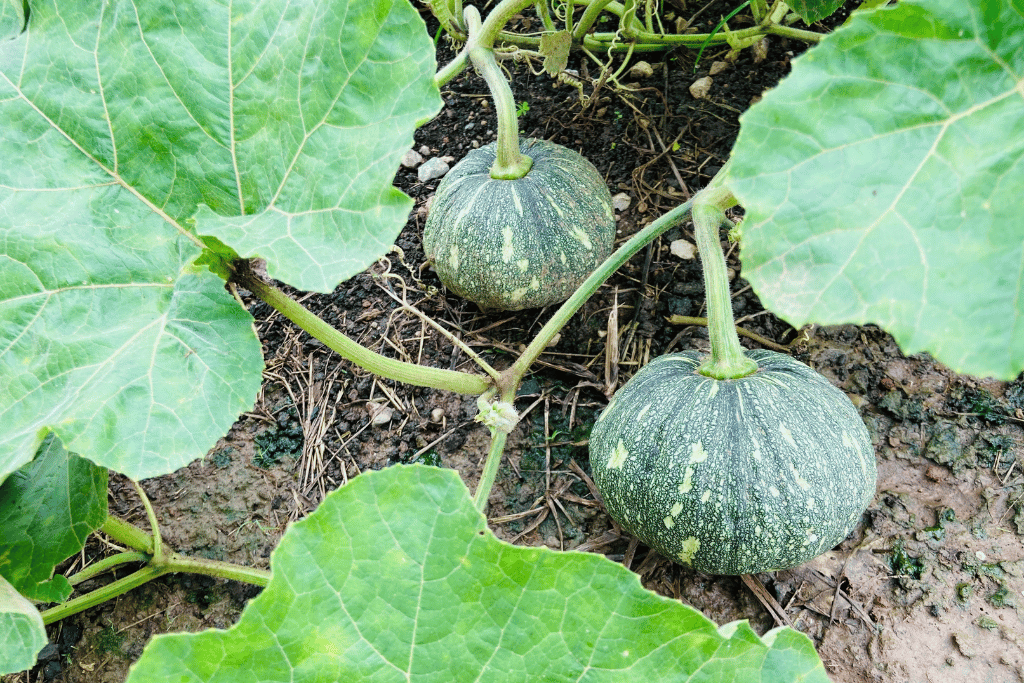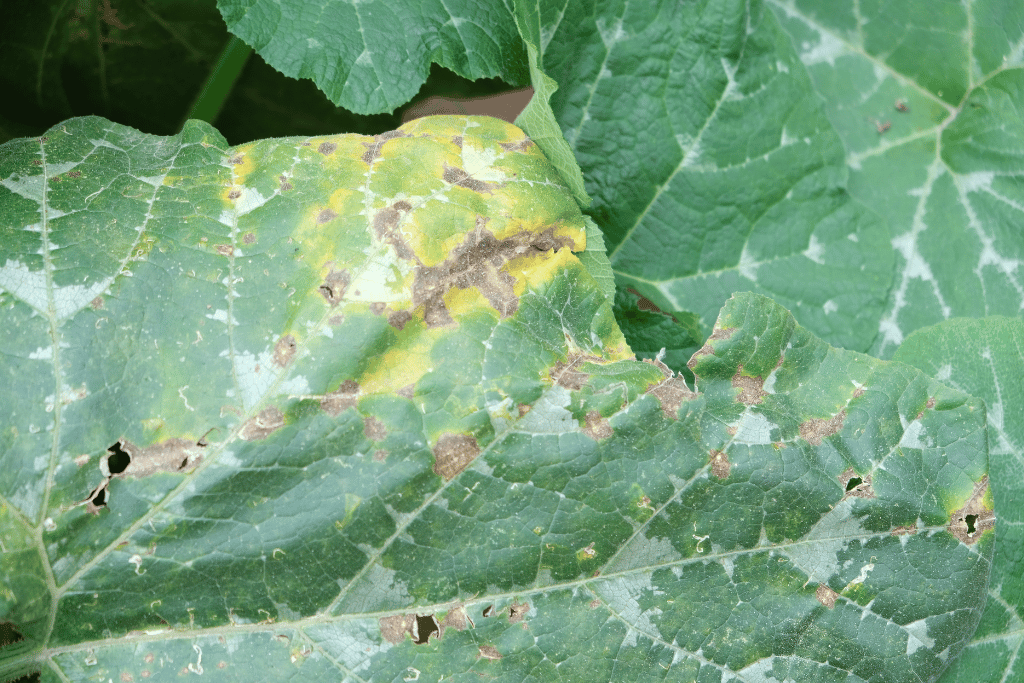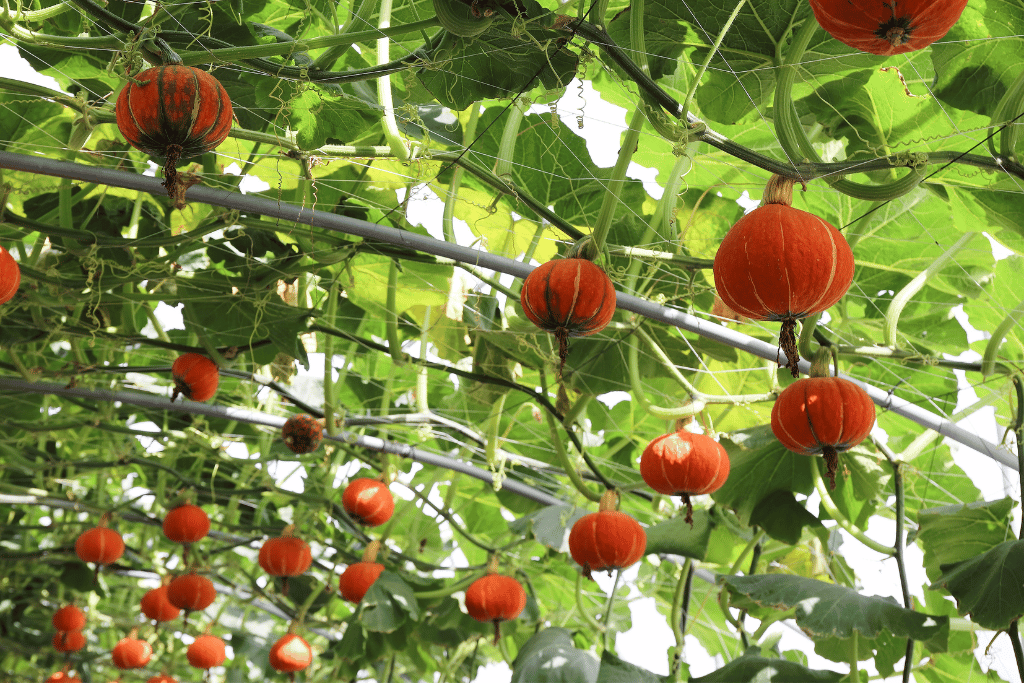
Well, butter my biscuits and call me a pumpkin patch! Have you ever heard of growing pumpkins on a trellis? It’s a game-changer. Not only does it save space, but it also gives your pumpkin patch a whole new level of jazz.
Every year I grow Thai Rai Kaw pumpkins on a trellis- well, on my garden chain link fence, actually. It frees up space in my veggie patches and functions as a privacy screen around my garden. At first, I was a little bit worried about the weight of the pumpkins, but by giving them a sling (made out of old t-shirts) to support the weight, they were just fine. Also, not keeping them on the floor prevented rotting at the base and reduced pests.
I can’t wait to guide you through the process of pumpkin growing on a trellis and explain all the details so you can have a go.
About Thai Raw Tok Pumpkin

Let’s look at the Thai Rai Kaw Tok pumpkin, a unique and delicious variety that will impress any pumpkin enthusiast. This plant has some impressive characteristics that make it stand out from the crowd.
Firstly, the Thai Rai Kaw Tok pumpkin is known for its stunning appearance: a deep green color with vibrant orange stripes that make it look like it’s straight out of a painting. You could say it’s the Picasso of pumpkins!
The Thai Rai Kaw Tok pumpkin is also part of the Curcubitaceae family, which includes other favorites like cucumbers and melons. It’s like being part of a big happy family—lots of diversity and plenty of love to go around.
This pumpkin originates from Thailand, where it has been grown for centuries and used in many traditional dishes. It’s like a culinary time capsule- a way to connect with a culture and its history through food.
But enough about its looks and origin- let’s have a look at how to care for this plant. It requires plenty of sun and well-draining soil, like most pumpkins. But it’s also a climbing vine, so providing a little bit of support goes a long way.
As for its uses, the Thai Rai Kaw Tok pumpkin is incredibly versatile. It can be roasted, pureed, baked into pies, or used in savory dishes like curries and stews.
Now you know a bit about this exciting pumpkin variety, let’s take a look at how and why to grow it on a trellis.
Advantages of Growing Pumpkins on a Trellis

Hold on to your gardening hat because we’ll uncover some sweet benefits of growing pumpkins on a trellis. If you’re working with limited space, using square-foot gardening techniques is like having your cake and eating it too- you can grow more veggies in a smaller area. And let’s be honest, who doesn’t want more veggies?
But it’s not just about space-saving. Growing pumpkins on a trellis also provides improved air circulation and light exposure for your plants. It’s like giving your pumpkins a spa day- they’ll come out healthier and more refreshed than ever.
Harvesting and pest management become a piece of cake when you grow your pumpkin on a trellis. You don’t need to scramble through all the vines on the ground to find your pumpkin. Plus, you won’t have to fight off all the creepy crawlies to get your pumpkin fix.
One year I grew pumpkins on the ground; let’s just say it was a hot mess. The vines took over my garden like a zombie apocalypse, and the pumpkins were covered in powdery mildew. But when I switched to a trellis, everything changed. I had more space, healthier plants, and easy harvesting. It was like a breath of fresh air after being stuck in a stuffy room.
So if you want to take your pumpkin growing to the next level, try growing pumpkins on a trellis; trust me, it’s easy as pie!
How to Grow Pumpkins On a Trellis

Ok, let’s have a look at the finer details of growing Thai Rai Kaw Tok pumpkin on a trellis.
Choose the Perfect Location
First things first, when it comes to selecting the trellis structure and location, you want to choose a spot that gets plenty of sunlight. Think of it like picking the perfect place for your beach chair- you want to catch some rays without getting burned.
It’s essential to consider factors such as sunlight, soil quality, and spacing. Choose a spot that receives at least six hours of direct sunlight daily and has well-draining soil. Avoid areas with heavy foot traffic or where other plants may compete for nutrients.
Installing the Trellis

Choose a sturdy trellis that can support the weight of your pumpkins as they grow.
After selecting the perfect location, dig parallel trenches for the trellis, secure them in place, and backfill the trenches with soil. Plant your pumpkin seeds at the base of each trellis post.
Here are some examples of different trellises you can use for growing pumpkins.
- A frame trellis: Made of two vertical posts and a horizontal beam across the top, forming an A shape. Strings or netting can be attached to the sides of the trellis to create a support system for the pumpkin vines to climb.
- Teepee trellis: Made of several vertical poles arranged in a circular shape and tied together at the top to form a teepee structure. The pumpkin vines can be trained to grow up the poles and then allowed to cascade down the sides of the trellis.
- Cattle Panel trellis: A cattle panel is a sturdy wire mesh commonly used in agriculture. The panel can be bent into an arch shape and secured into the ground with metal stakes. The pumpkin vines can be trained to grow up the panel using the mesh as support.
- Fence trellis: If you have a sturdy fence in your garden, you can use it as a trellis for your pumpkin vines. Simply attach strings or netting to the fence and train the vines to climb up the support.
- T-bar trellis: Made of two vertical posts with a horizontal bar across the top. Strings or netting can be attached to the bar to create a support system for the pumpkin vines to climb. This design is handy for small gardens, as it takes up minimal space.
You can construct your own trellis using recycled materials too; keep an eye out for any wire rack-type structures to use. One year I used an old clothes drying rack to train my pumpkins, which worked well.
Prepare the Soil and Planting

Next up- preparing the soil and plant seeds. You’ll want to loosen up the soil and mix in some compost, like fluffing a pillow, before settling in for a nap. Then plant the seeds and water them well.
To start, test the soil pH and make sure it falls within the optimal range of 6.0 to 6.8. Loosen the soil to a depth of at least 12 inches and remove any weeds or debris. Incorporate organic matter like compost or manure to improve soil fertility and structure.
Finally, create mounds or hills for your pumpkin seeds, spaced according to their recommended planting distance. Proper soil preparation sets the stage for healthy pumpkin growth and a bountiful harvest.
Training the Vines
As your pumpkins start to grow, you’ll need to train them up the trellis. Gently guide the vines up the trellis and use twine or netting for support. You may need to do some pruning to keep things in check. Cut back any excessive growth or leaves that may be blocking sunlight.
Fertilization, Watering, and Pest Control

Now onto fertilization, watering, and pest control. It’s like feeding and watering your pet- you want to give them the best care possible.
Use a balanced fertilizer and water your pumpkins regularly, making sure not to overdo it. Pumpkins are heavy feeders and require rich, nutrient-dense soil to grow well. Before planting, work in a generous amount of compost or well-rotted manure into the soil. Once the plants have sprouted, you can fertilize them every two or three weeks with a balanced fertilizer that is high in nitrogen, phosphorus, and potassium.
And when it comes to pests, keep an eye out for any unwanted guests and take action as needed. Pumpkins are susceptible to pests, including squash bugs, cucumber beetles, and vine borers.
One effective pest control method is to plant a companion marigold crop, which repels many common pumpkin pests. Regularly inspect the plants for signs of infestation and remove any affected leaves or fruit. You can also use organic insecticides or natural predators like ladybugs and praying mantises to control pest populations.
When it comes to watering pumpkins, water deeply once a week, providing enough water to soak the soil to a depth of 6-8 inches. Avoid getting water on the leaves, which can lead to fungal diseases. Mulching around the base of the plants with straw or wood chips can help retain moisture in the soil and reduce the watering frequency.
Harvesting and Storing

Now the exciting final steps- harvesting and storing your Thai Rai Kaw Tok pumpkins. First things first, you need to know when your pumpkins are ready to be picked.
Look for signs like hard outer skin, a dull sound when tapped, and a withering stem. It’s like waiting for your cake to bake- you want to make sure it’s fully cooked before diving in!
Once you’ve determined your pumpkins are ready, it’s time to break out the cutting tools. Use a sharp knife or pair of scissors to cut the stem about two inches above the pumpkin.
Now onto storing your pumpkins. You want to keep them in a cool, dry place like a pantry or root cellar. And make sure to check them regularly to ensure they are not rotting or going bad.
Pro Tip: If you’re feeling a little extra fancy, you can even roast your pumpkin seeds for a tasty snack. You can use them like sprinkles on a salad or eat them as they are for extra nutrition.
Pumpkin Trellis: Growing up and Reaping Big with a Vine Idea

We’ve covered a lot of ground on growing Thai Rai Kaw Tok pumpkins on a trellis. To recap, growing pumpkins on a trellis has many benefits, such as maximizing limited space, improving air circulation and light exposure, and making harvesting and pest management a breeze. And when it comes to Thai Rai Kaw Tok pumpkins specifically, it’s an easy and rewarding variety to grow with a delicious flavor.
So for all my pumpkin-loving friends out there, I encourage you to try growing pumpkins on a trellis. It’s like taking on a new exciting challenge-a bit daunting but ultimately rewarding.
Are Your Plants Looking a Little Worse for Wear?
Don’t let them wither away like a flower in the desert! It’s time to dig in and give them some tender, loving care. Join our community of plant lovers and learn all the tricks of the trade to keep your plants blooming. We’ve got everything from watering and fertilizing to pruning and pest control.
Let us help you cultivate the green thumb of your dreams. You’ll be the envy of all your friends, and your plants will be happier than a pig in mud!
Frequently Asked Questions (FAQ)
What is the best trellis structure to use for growing Thai Rai Kaw Tok pumpkins on a trellis?
Thai Rai Kaw Tok pumpkins require a strong and sturdy trellis structure, such as a metal or wooden trellis. The trellis should be at least 6 feet tall and 2-3 feet wide to provide ample support for the vines and the weight of the pumpkins.
How do you prepare the soil for planting Thai Rai Kaw Tok pumpkin seeds?
The soil should be well-drained and rich in organic matter. Before planting, amend the soil with compost or aged manure to add nutrients and improve soil structure. A soil pH of 6.0 to 6.8 is optimal for growing pumpkins.
How often should Thai Rai Kaw Tok pumpkins be watered?
Thai Rai Kaw Tok pumpkin requires consistent moisture, especially during the growing season. They should be watered deeply once a week or more frequently during hot or dry weather periods.
What pests and diseases are common in Thai Rai Kaw Tok pumpkin plants?
Common pests include squash bugs, cucumber beetles, and vine borers. Diseases such as powdery mildew and bacterial wilt can also affect plants. To prevent and manage these issues, practice good sanitation, rotate crops, and use organic pest control methods.
When are Thai Rai Kaw Tok pumpkins ready to harvest?
Thai Rai Kaw Tok pumpkins are ready to harvest when the skin turns a deep orange color, and the stem begins to dry and crack. The pumpkins should be cut from the vine with a sharp knife leaving a few inches of the stem intact. They can be stored in a cool, dry place for several weeks.



